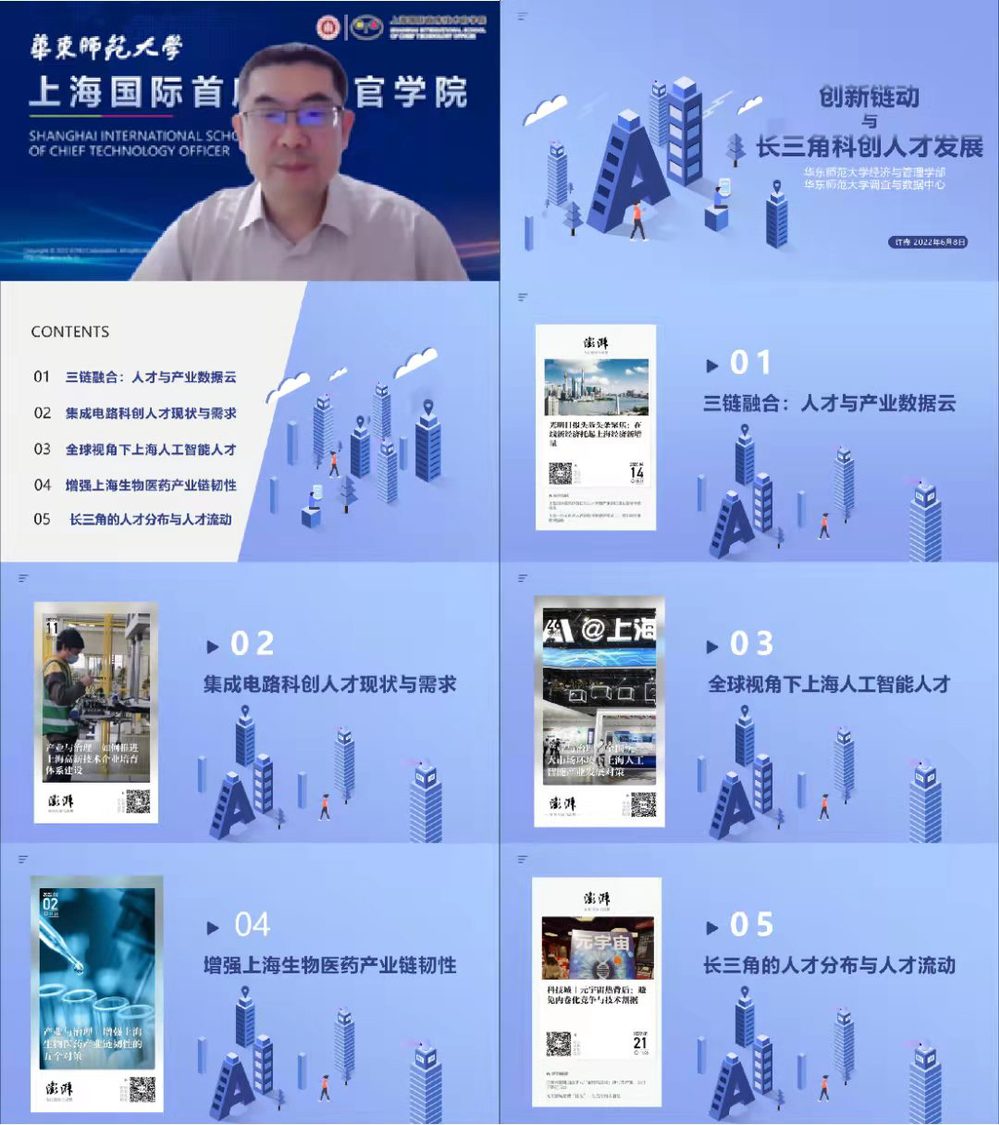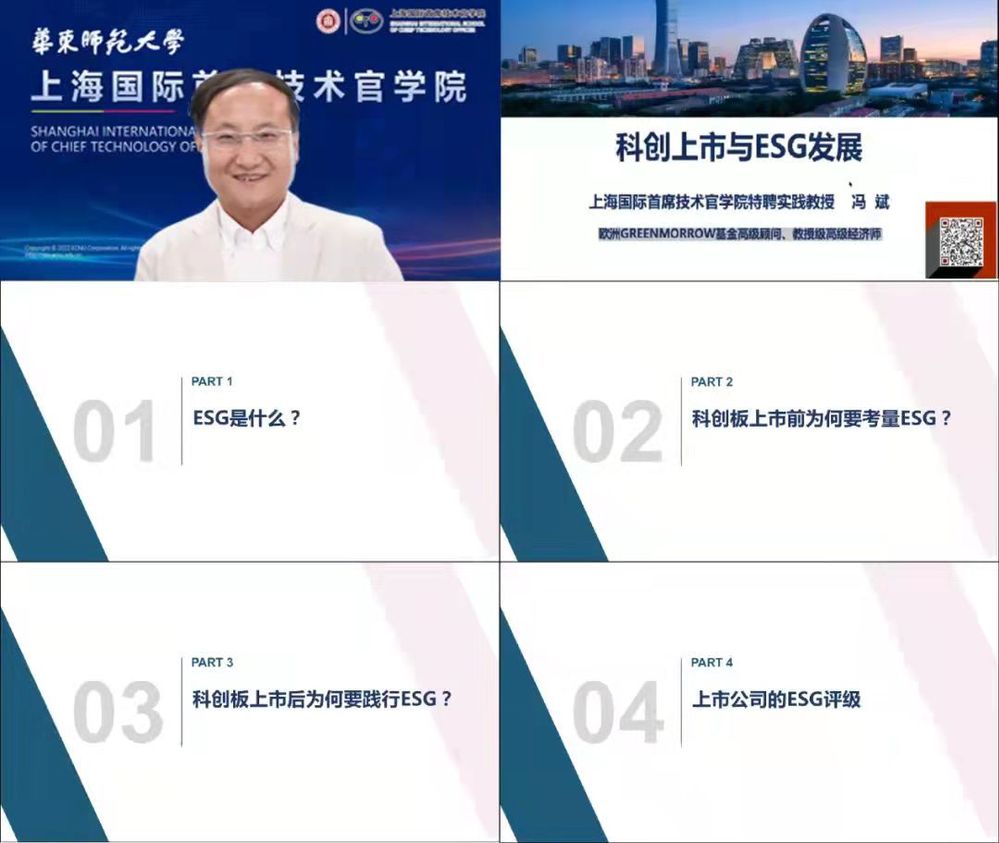On the afternoon of June 9, the fourth open class of East China Normal University MEM, hosted by ECNU Shanghai International School of Chief Technology Officer (hereinafter referred to as “CTO School”) and co-organized by Shanghai Minhang District Committee Chunshen Pyramid Talent College, Shanghai Lingang Caohejing Talent Co., Ltd., Shanghai Pudong New Area Talent Market and China-Israel (Shanghai) Innovation Park, was successfully held in the form of a video livestreaming.

Prof. Xu Xin, Academic Mentor of CTO School and Vice Dean of the Institute of Humanities and Social Sciences of East China Normal University and Feng Bin, Distinguished Professor of Practice of CTO School and Senior Consultant of the Europe GreenMorrow Sustainable Development Fund, respectively, gave lectures on the themes of Innovation Synergy, ESG Development and Career Advancement.
At the beginning of the class, Professor Xu Xin, Academic Mentor of CTO School, gave a lecture entitled “Innovation Link and Development of Scientific Creative Talents in Yangtze River Delta”. Through the research on the relationship among the talent chain, industrial chain and innovation chain, Professor Xu Xin has established a talent evaluation system oriented by innovation value, ability and contribution, and formed and implemented an evaluation system conducive to dedicated research and innovation by scientific and technological talents. In addition, the “Talent and Industry Data Cloud Platform” connects talent characteristics with industrial demand characteristics by constructing innovation theme tags, providing data support for the study of the three industrial chains and providing precise and powerful support for national and individual decision-making. Professor Xu Xin shared the development status and talent demand characteristics of integrated circuit, artificial intelligence and biomedical industry.
In the field of integrated circuit scientific innovation, Professor Xu Xin took the status quo and demand of scientific innovation talents as the research direction and reached the conclusion through the DLM big data model analysis that the agglomeration effect of scientific and technological innovation talents in Pudong New Area is remarkable, enterprises have become the clustering highland of scientific and technological innovation talents, leading enterprises have become the clustering highland of leading research and development talents and universities and research institutes have become the clustering base of leading talents. Prof. Xu Xin pointed out the lack of school-enterprise cooperation hinders the cultivation and delivery of scientific and technological innovation talents to a certain extent, the number of high-quality R&D talents focused on upstream design is still low and leading talents from universities and research institutes fail to fully realize the university-enterprise co-driving innovation mode and the allocation of scientific and technological innovation talents is inefficient. On the whole, the cultivation of integrated circuit innovative talents in colleges and universities is insufficient, and the cultivation of integrated circuit talents in colleges and universities focuses on the design link, resulting in a large gap of important innovative R&D talents such as doctoral students and full-time basic skilled talents such as the junior college degree.
In terms of the artificial intelligence industry, Professor Xu Xin pointed out that the scale of the industry is growing rapidly and the agglomeration effect is prominent through comparison from a global perspective. Among them, AI application scenarios are rich and the trend of AI empowering hundreds of industries is accelerating. The innovation resources are abundant and innovation results are in the forefront. The Shanghai standard of the AI governance system “Shanghai standard” cut a figure. In addition, AI is not limited to the computer industry and the trend of AI discipline convergence is accelerating. Statistical data show that even in the global scope, Shanghai's talent training capacity is still strong, showing remarkable talent growth.
In terms of the biomedical industry chain, Shanghai has formed a number of biomedical industry characteristic parks. Each park has its own characteristics and staggered development. Shanghai biomedical technology research and development focuses on the global frontier and has formed four major talent groups: overseas high-level expert and scientist group, innovative entrepreneur group, research and development talent group, and engineer and high-level skill talents. Shanghai leads the country in research and development in the upstream of the biomedical industry chain, continues to make efforts in the middle stream, and make characteristic development in the downstream. In view of Shanghai biomedical industry chain, Professor Xu Xin put forward countermeasures and suggestions, that is, Shanghai as the leader, join hands with the Yangtze River Delta to build a world-class biomedical cluster.
Finally, Professor Xu Xin took regional cities of the “G60 scientific and technological innovation corridor” as the research objects to analyze the distribution and flow of talents in the Yangtze River Delta region of China.

Next, Feng Bin, Distinguished Professor of Practice of CTO School, gave a lecture on “Listing of Science and Technology Innovation and ESG Development”. Professor Feng Bin analyzed the listing of science and technology innovation and the development context of ESG, and discussed what ESG is, why ESG should be considered before the listing in the STAR Market, why ESG should be practiced after the listing in the STAR Market, and the ESG rating of listed companies.
STAR Market listing and ESG development context. The State-owned Assets Supervision and Administration Commission of the State Council has set up a social responsibility bureau, which requires that the ESG special report disclosure of listed companies held by central enterprises be fully covered by 2023. Recently, Ant Financial, the largest fintech company listed on the STAR Market in China, also took the initiative to disclose the ESG report of 2021. Feng Bin pointed out that the STAR Market was set up in the Shanghai Stock Exchange and the registration system was piloted, and it is a measure to target high-tech enterprises and drive the strategy of building a technology powerhouse. The effective implementation of ESG can reduce the risk of management and control, which is an inevitable trend for companies to get financial support.
ESG includes three dimensions: environment, society and governance and it was explicitly proposed in the United Nations Global Compact in 2004. Different from the traditional financial and business performance evaluation, ESG rating focuses on enterprises' environmental, social and governance performance and evaluates enterprises' contributions in promoting sustainable economic development and fulfilling social responsibilities.
Why should ESG be considered before listing in the STAR Market? China has successively issued its own documents, laws and regulations, making suggestions and regulations for ESG and important issues of ESG have been included in the prospectus, including the environment, social responsibility and corporate governance. Attention should be paid to ESG in the review and inquiries. Failure to disclose or conceal material ESG information in the prospectus may affect the IPO. ESG compliance risk can affect valuation and even become a barrier to equity financing. Blackstone, the world's largest equity investment institution, has established a global ESG team, which takes ESG alongside business, legal and finance as an important reference dimension when acquiring and investing in assets. Companies that perform well on ESG will have lower debt financing costs. It is important to note that many institutions and professionals do not distinguish between ESG practice and investment, investment institutions implement the ESG concept to investment and the ESG practice is for enterprises to improve non-financial performance evaluations by the ESG standards.
Why ESG should be practiced after listing in the STAR Market? ESG has become a bridge for listed companies to connect the secondary market, foreign and domestic funds. The ESG management scale in major global markets and the scale of global assets management are rising every year. ESG can also lead the sustainable development of enterprises on the STAR Market. Ninety companies have independently compiled and released social responsibility reports or ESG reports and all companies on the STAR Market have exclusively disclosed ESG information in their annual reports.
At present, there are five ESG ratings for the mainstream listed companies in the world, among which the most influential is MSCI rating that has 3 dimensions, 10 themes and 37 key evaluation indicators. Professor Feng Bin pointed out that ESG is the standard for judging good enterprises. Enterprises that do not take ESG into account will find it difficult to go public and their valuation and financing after listing will also be affected. Enterprises should develop ESG from the perspective of management, compliance and high-quality development.
The Master of Engineering Management (MEM) program of East China Normal University aims to cultivate middle and senior management leaders with technology + management talent in science and technology innovation industry, enterprises, government and public administration departments. The program takes the initiative to develop a “4+X” CTO training curriculum system. The system logic of “4+X” extends to the direction of emergency technology and management and the direction of major project management. “4” includes thinking logic, emergency management (complex management), senior management ability and technology transfer. “X” is based on the field of public health. The practice and innovation platform has 8 industry-education integration demonstration bases and a full-chain ecological service platform for scientific and technological innovation.
The East China Normal University MEM open class lasted nearly two hours and came to a successful close.

